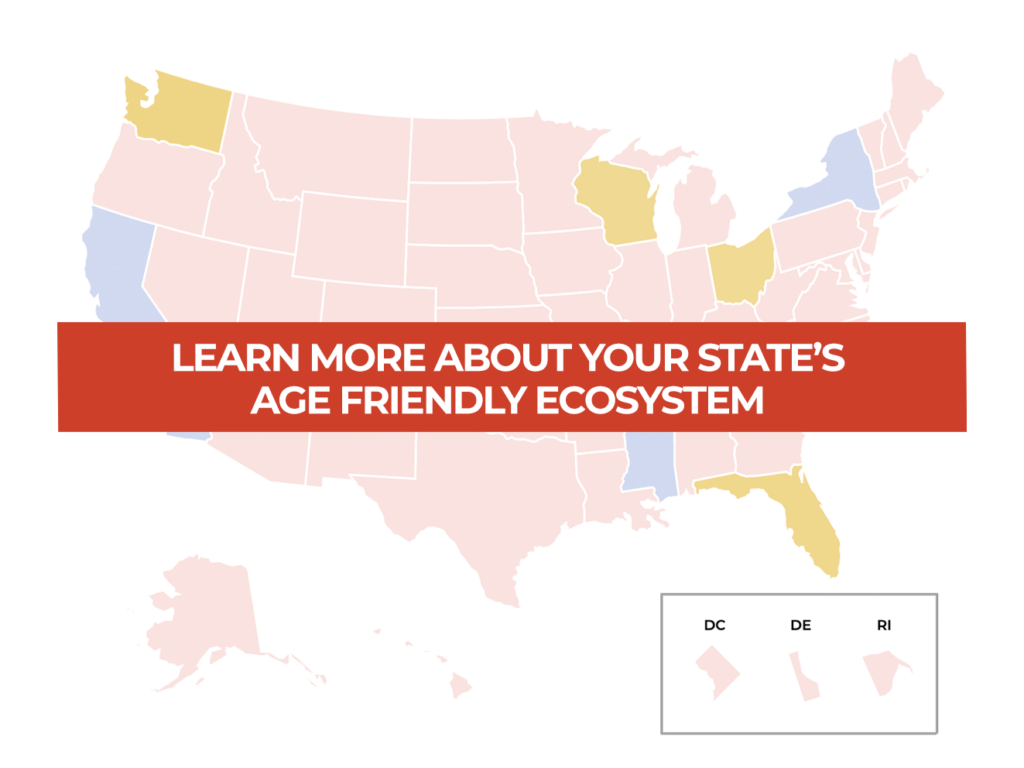Age-Friendly EcoSystem
Wholistically addressing older adult health requires a multi-sector, collaborative approach that prioritizes equity and promotes policies and environments that foster healthy aging across the life span. An ideal system of care aligns frameworks and strategies across sectors to create a seamless care journey that meets the health and social needs of older adults and their caregivers.
Each of the sectors represented by the age-friendly ecosystem model has much to contribute to support the health and well-being of older adults and caregivers. However, greater alignment among these sectors is necessary for policy and program efficiency, reducing silos, and maximizing limited resources. TFAH is working with partners to overcome the barriers to alignment by increasing knowledge among each sector and working intentionally to identify and bridge gaps in care from hospital to community to home.
Age-Friendly Public Health Systems (Trust for America’s Health) Becoming an Age-Friendly Public Health System (AFPHS) means that healthy aging is elevated as a core function of a state, territorial, tribal, or local health department. The AFPHS 6Cs framework offers an outline for this transformation, from “creating and leading change”, to “connecting and convening” multiple partners, to “communicating” important public health information, to “collecting, analyzing and translating” data on older adult health. Departments of health at all levels can serve as the convener and connector among all relevant age-friendly initiatives.
Age-Friendly Health Systems (Institute for Healthcare Improvement) Becoming an Age-Friendly Health System (AFHS) entails providing a set of four evidence-based elements of high-quality care in a clinical or nursing home setting. The AFHS 4Ms model for older adult care includes considering “What Matters” to an older adult; ensuring “Medication” is necessary and does not interfere with mobility or mental state; preventing, identifying and managing “Mentation”; and ensuring that older adults have “Mobility”, or can move safely every day and in every setting to maintain function. The 4Ms can also inform public health practice as public health practitioners can apply these principles to a population health approach, ensuring that “What Matters” to older adults as a population group is considered in assessment and planning activities.
Aging Services Sector (USAging) The aging services sector, primarily consisting of local Area Agencies on Aging, State Units on Aging, and the home and community-based services sector, has been serving older adults and caregivers in the community for many years. This sector works to improve the quality of life and health of older adults and people with disabilities, including supporting people with chronic illness, people living with dementia, family caregivers and others who want to age well at home and in the community.
AARP Network of Age-Friendly States and Communities (AARP) The Age-Friendly Communities model supports livable communities, aiming to create communities that are safe, and equitably serving residents of all ages, ability levels, incomes, races, ethnicities, and other backgrounds. Livable communities aim to enhance personal independence; allow residents to remain in their homes and communities as they age; and provide opportunities for residents of all ages, ability levels, and backgrounds to engage fully in civic, economic, and social life.
Age-Friendly University Global Network (Arizona State University) The Age-Friendly Global Network is a movement that aims to shape how we live and work by increasing educational opportunities across the life span. Institutions that endorse and adopt the AFUGN principles commit to, recognizing the range of educational needs of older adults, promote intergenerational learning, and ensuring that the institution’s research agenda is informed by the needs of an aging population. This movement can contribute to the health journey of older adults and caregivers by working with the public health sector to promote inclusivity in community health assessments and expanding their research agenda to identify future population health solutions to older adult health challenges.

